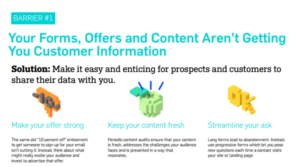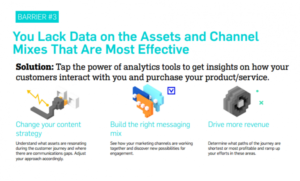New topics get as much attention these days in marketing and sales circles as those related to the “customer journey.” According to a new ebook from IBM, 80% of consumers don’t think brands understand them as individuals, so CMOs are correctly allocating resources to improving the customer acquisition process.
Initially introduced by IDEO in the late 1990s while working on a project for Acela, the concept of customer journey mapping was quickly embraced and proselytized by consultants and leading companies around the world. The subsequent explosion of digital technologies had a dramatic effect on customer journey planning – increasing its complexity dramatically, and perhaps even exponentially – and fueled the growth of what is now effectively its own industry category.
What is the Customer Journey?
In its simplest form, the (pre-acquisition) customer journey is the sum of the steps that an individual or company takes before becoming a customer. The “customer journey map” is typically a visual representation of that process, and often conveys considerable detail. This example neatly summarizes a customer’s path to purchasing broadband internet service, but the journeys differ dramatically according to the unique dynamics of customer type, product, price, and company (think: purchasing a new pair of jeans at Old Navy versus Bloomingdale’s).
The close cousin to the customer journey is the “customer experience,” which can be generally understood as the post-acquisition activities that place, and are aimed at maximizing client satisfaction and/or cross- and up-selling complementary goods and services.
What You Need to Know
Given the myriad variables involved in the customer journey planning and optimization process, it’s easy to get off-track. The new ebook from IBM does a good job of identifying three common barriers, and tips for how to address them. Our take on its recommendations follows.
- Stay Focused On What You Can Control. End-to-end customer journeys can involve just about every functional area of an organization – from product managers to IT resources and finance, as well as third party vendors with tightly defined contracts. Successfully implementing behavioral changes in any area you don’t have full management control over can be time-consuming and costly, if not in actually dollars than in political capital. For example, we recommend that marketers focus the bulk of their efforts on optimizing offers, content, on-page creative assets, forms, etc. (Barrier #1). Likewise, technology teams are best served by reworking applications and infrastructure.
- Be Realistic About What Can Be Accomplished. Recommendations such as “use a single identity” and “stop doing channel-by-channel marketing” (Barrier #2) are generally agreed-upon industry best practices, but also exceedingly difficult to implement, especially at large companies with sprawling operations. Keeping these goals in the conversation as long-term aspirations makes sense for most companies, but are realistic goals for only a fraction of sizable organizations in the short term.
- Employ a ‘Ready, Fire, Aim” Philosophy. Customer journey initiatives go hand-in-hand with digital strategies, and the digital technology landscape continues to mushroom, with hundreds of affordable new solutions introduced each year. High-performing companies understand that frequent missteps are part and parcel of the process, and have learned to ‘fail fast’ by relying on data-based measurement strategies (Barrier #3). With the easy and often free availability of sophisticated tracking tools such as Google Analytics, companies of every size and stripe can confidently rely on performance statistics to drive behavior. While the adoption and learning curve can be steep – many of the free tools are complex – especially for companies overly reliant on old school tactics, the benefits are considerable.
Tim Bourgeois (@ChiefDigOfficer) is a director at East Coast Catalyst, a digital strategy consulting company specializing in strategic roadmaps, digital marketing audits, and online marketing optimization programs.
This article was originally posted on InContext, which is published by Digital Content Next—the only trade organization dedicated to serving the unique and diverse needs of high-quality digital content companies that manage trusted, direct relationships with consumers and marketers. Follow Digital Content Next (DCN) @DCNorg or subscribe to their email newsletter.
FURTHER READING
Digital Marketing Audit: The ECC Methodology & Approach
Ad Fraud Detection Techniques & Strategies for Marketers
Programmatic Advertising Trends: Dealing With Fraud & Negative Experiences
Online advertising fraud & CMO strategies
Digital Marketing Best Practices


